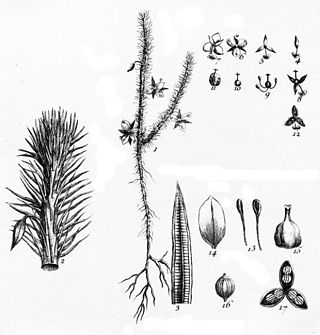
Stanhopea is a genus of the orchid family (Orchidaceae) from Central and South America. The abbreviation used in horticultural trade is Stan. The genus is named for the 4th Earl of Stanhope (1781-1855), president of the Medico-Botanical Society of London (1829-1837). It comprises 55 species and 5 natural hybrids. These epiphytic, but occasionally terrestrial orchids can be found in damp forests from Mexico to Trinidad to NW Argentina. Their ovate pseudobulbs carry from the top one long, plicate, elliptic leaf.

Chusquea is a genus of evergreen bamboos in the grass family. Most of them are native to mountain habitats in Latin America, from Mexico to southern Chile and Argentina.

Clethra is a genus of flowering shrubs or small trees described as a genus by Linnaeus in 1753.

Mayaca is a genus of flowering plants, often placed in its own family, the Mayacaceae. In the APG II system of 2003, it is assigned to the order Poales in the clade commelinids. The Cronquist system, of 1981, also recognised such a family and placed it in the order Commelinales in the subclass Commelinidae.

Caryocaraceae is a small family of flowering plants consisting of two genera with 26 species. The family is native to tropical regions of Central and South America, as well as the West Indies.

Perrottetia is a genus of flowering plants in the family Dipentodontaceae described in 1824. Species occur in China, Southeast Asia, Papuasia, Hawaii, Australia, and Latin America. It is the largest genus of the recently described order Huerteales.

Lepechinia is a genus of plants in the mint family, Lamiaceae. It includes several species of plants known commonly as pitchersages. Plants of this genus can be found in Central and South America, Mexico, California, Hispaniola, and Hawaii, although the species in Hawaii is probably a human introduction. Many of them bear attractive pitcher-shaped flowers, often in shades of purple. The genus was named for the Russian botanist Ivan Ivanovich Lepechin. In 2011, the two monotypic genera Chaunostoma and Neoeplingia were shown to be part of Lepechinia.

Pseudogynoxys is a genus of flowering plant in the groundsel tribe within the sunflower family, native to North and South America.

Brunellia is a genus of trees. They are distributed in the mountainous regions of southern Mexico, Central America, West Indies, and South America. Brunellia is the only genus in the family Brunelliaceae. As of 2001 there were about 54 species.

Calatola columbiana is a species of flowering plant in the family Metteniusaceae. It was formerly placed in the family Icacinaceae. It is endemic to Colombia.

Citharexylum is a genus of flowering plants in the verbena family, Verbenaceae. It contains shrub and tree species commonly known as fiddlewoods or zitherwoods. They are native to the Americas, ranging from southern Florida and Texas in the United States to Argentina. The highest diversity occurs in Mexico and the Andes. The generic name is derived from the Greek words κιθάρα (kithara), meaning "lyre", and ξύλον (xylon), meaning "wood," referring to the use of the wood in the sounding boards of string instruments. Several species, especially C. caudatum and C. spinosum, are cultivated as ornamentals.

Trichostigma peruvianum is a species of flowering plant in the family Petiveriaceae. It was formerly placed in the family Phytolaccaceae. It is native to Ecuador, Colombia, and Peru.

Metteniusaceae are a family of flowering plants, the only family in the order Metteniusales. It consists of about 10 genera and 50 species of trees, shrubs, and lianas, primarily of the tropics. The family was formerly restricted to just Metteniusa, but it is now expanded with a number of genera that were formerly placed in the widely polyphyletic Icacinaceae.
Guamatela is a genus of flowering plants in the order Crossosomatales. Guamatela is the only genus in the family Guamatelaceae. The genus comprises a single species, the type species, Guamatela tuerckheimii Donn.Sm., an evergreen shrub with a prostrate habit that is native to Mexico, Guatemala, and Honduras. The genus Guamatela had formerly been included in the family Rosaceae before the Angiosperm Phylogeny Group placed it in the Guamatelaceae in 2009.

Dialypetalantheae, synonym Condamineeae, is a tribe of flowering plants in the family Rubiaceae and contains about 305 species in 31 genera. Most genera are found in Central and Southern Tropical America, but a few occur in Southeast Asia.
Dendrobangia is a genus of flowering plants in the family Metteniusaceae. It was formerly placed in the family Cardiopteridaceae. It was described as a genus in 1896.

Schlegelia is a group of plants described as a genus in 1844. The genus is named after the German anatomist and physician Paul Marquard Schlegel.
Escobedia is a genus of flowering plants belonging to the family Orobanchaceae.

Ipomoea batatoides is a species of flowering plant in the family Convolvulaceae.

Chaetogastra mollis is a species of flowering plant in the family Melastomataceae, native to western South America. It was first described by Aimé Bonpland as Rhexia mollis in part of Monographia Melastomacearum, volume 2, published in 1808. Its synonyms include Tibouchina mollis.


















